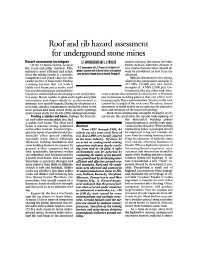Mining Publication: Roof and Rib Hazard Assessment for Underground Stone Mines
Original creation date: January 1998
From 1991 through 1995, 44 miners out of a total work force of less than 2,000 were fatally injured in the stone industry. Of these, 12 occurred at underground mining operations with nine deaths resulting from roof or rib falls. A safer environment can be achieved by evaluating the nature of the hazardous ground and by developing more efficient and effective ground-control strategies. Roof and rib conditions were observed and assessed in 33 underground stone mines in Illinois, Indiana, Kentucky, Maryland, Missouri, Pennsylvania and West Virginia. Hazard assessment indicated that the ground failures that occurred under moderate to substantial overburden, i.e., >30 m (100 ft), were caused by stress concentrations and geologic structures. Ground failures near the surface are caused by solution (water) processes. Selection of the mining horizon and mine-layout decisions tremendously influence ground stability.
Authors: AT Iannacchione, LJ Prosser
See Also
- Assessing Roof Fall Hazards for Underground Stone Mines: A Proposed Methodology
- A Computer Software Program that Estimates Air Quantity Requirements in Large Opening Stone Mines
- Current trends in Reducing Ground Fall Accidents in US Coal Mines
- Current Trends in Reducing Ground Fall Accidents in US Coal Mines
- Dynamic Failure in Deep Coal: Recent Trends and a Path Forward
- Preventing Injuries Caused by Unrecognized Stone Mine Roof Beam Failures With a Pro-Active Roof Control Plan
- Roof and Rib Fall Incident Trends: a 10-Year Profile
- Stability Mapping to Examine Ground Failure Risk: A Field Study at a Limestone Mine
- Technique to Assess Hazards in Underground Stone Mines: the Roof Fall Risk Index (RFRI)
- Technology News 520 - A Method to Characterize Risk Associated With Mine Roof Conditions
- Content source: National Institute for Occupational Safety and Health, Mining Program


 ShareCompartir
ShareCompartir
